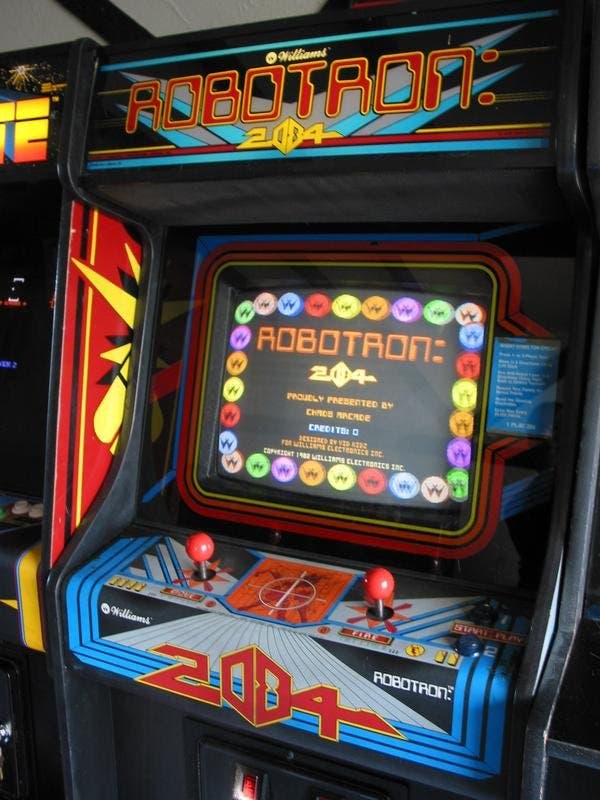Retrospective: Robotron: 2084
The soul of a new machine.
For a few months after its release, he kept a close eye on his creation. Perhaps he would wander around Chicago on those serene, silver-skied early evenings they have there, checking in at the chattering, buzzing arcades, the smoky dives, the pizza places where locals - kids and adults back then - would gather around the tall black machines in the corner, while a polite line of quarters stretched across the cabinet tops.
He was a pro by this point, which meant that he was looking for some very specific signs. Adoring crowds were nice enough, but that wasn't what he was truly after, and he wasn't checking the leaderboards, either, to try and get a sense of how much traffic his game was getting. Instead, he was looking for abuse: footprints where the cab had received a dusty shoeing in a wordless moment of blunt frustration, joysticks torn off in anger, tiny cracks in the screen, cigarette burns that seemed a little too deliberate.
I imagine he found plenty of what he was searching for. Modern games may flatter their punters, but arcade classics were always more likely to taunt them. The very best would be openly hostile - and Robotron: 2084 was the very best. It made people furious. It made them feel cheated, even, because it took their money and gave them, what? 15 seconds? 20 seconds? And that time was mostly spent in abject humiliation, struggling with the controls, hunting around for, like, a button - there must be a button somewhere, right? - before expiring in a gaudy fizz of light, leaving nothing but the feeling that players were expected to know how to pat their heads and rub their stomachs at the same time with this one.
Inevitably, though, it made them come back, too. Again and again. The abuse was simply the first sign of love.

Eugene Jarvis had wanted to make pinball games. He loved pinball, with its brutal simplicity, its ball-bearings, fairy lights and bells. He loved its sense of street-smart engineering: all screwdrivers, twills of wire and lumps of chrome. Pinball was pretty sexy for a while - in Foucault's Pendulum, Umberto Eco writes a slightly sweaty love letter to it, having watched a girl grind her hips against the cabinet as she played. But Jarvis was born 20 years too late to catch the trend in its prime, so he mostly had to make videogames instead.
He did. He made Defender - and the advance buzz said that Defender was a big fat bomb. Too many buttons, too many objectives, too many different things to remember. Defender just had too much for the human brain to learn, and it killed you too often. It killed you all the time, actually, and in ways that players, groomed on the polite, entirely mechanical, armadas of Space Invaders, struggled with. It was chaotic and mean-spirited and a bit garish. Maybe there was a personal insight hidden in there somewhere: photos of Jarvis from that time depict a lanky character with a Unabomber approach to haircuts and a look in his eyes suggesting that every day was Halloween.
Naturally, Defender was a gigantic hit. Even Martin Amis liked it, and he hardly liked anything. Jarvis and a fellow developer named Larry DeMar formed a separate company and produced Stargate, an enhanced version of his breakout success. But for the first proper follow-up, the duo knew they had to do something really unexpected.
Eager to please, Jarvis promptly had a car accident - I'm sure I remember reading that he was driving something hilarious like a Ferrari or an old garbage truck, but I may be wrong - and he wound up with a broken hand. Ha! It turned out to be the most valuable broken hand in the short history of videogames. If he'd broken a leg too, who knows what he might have eventually accomplished?
Simplicity is hard to plan for, apparently. You have to just let it sneak up on you, like old age, bankruptcy or a real thing for cricket. After a lot of over-complicated designs, fumbling around for a control scheme he could test while his hand was in plaster, Jarvis ended up bolting two joysticks together and taping his cast to one of them. It wasn't the first time anyone had experimented with the layout - Taito had tried a similar approach the year beforehand, and stunk the place up - but now, something clicked between designer and hardware. It turned out that two joysticks - one to move, one to fire - felt pretty good after a while. You had a lot of manoeuvrability, a lot of options. And to Jarvis and DeMar, that meant only one thing: it meant they could afford to throw a lot of trouble your way.

